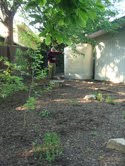Homeowner sees green in Holmes Run Acres

The idea came with the rain—shooting off the broad, low-slung roof of Margaret Garigan’s Annandale house, blasting across the tattered fescue, alopecic moss, and exposed roots of her backyard, gouging gullies through the barren clay, then burrowing under a soggy corner of the neighbor’s fence.
Driving to work on those rainy days, she was pretty sure the muddy freshet charging across Gallows Road was her yard on its way to the Chesapeake Bay. Something had to be done. And she did it.
Now, four years later, the mid-century modern house in Holmes Run Acres is for sale, and Garigan is showcasing its value as a watershed-friendly property, as well as its elegant lines, convenient location, and energy efficiency. It has a hybrid heating and cooling system that has brought her energy bills down to just $60 a month.
Garigan’s house reflects an emerging trend in real-estate that values outdoor “green” elements, as well as indoor sustainability.

Four years ago, she realized the impermeable roof, sodden clay-pack yard, and concrete patio prevented stormwater from seeping into the soil. She and her partner, Victor, used several low-impact development techniques to prevent water and soil run-off. They did most of the work themselves with free or low-cost resources and training from Fairfax County and community nonprofit groups.
To demonstrate what a “watershed-friendly” home environment can look like, Margaret and Victor opened their house and garden on a recent mild, spring evening to neighbors, realtors, and the water-resources community.
Thyme was blooming beneath Concord grape vines, and raised beds full of lettuces lined the permeable gravel drive installed by the local non-profit, ReBuild Warehouse. Biologists and gardeners strolled along the old tulip trees and young amelanchier bushes in the lush yard, discussing elderberry cultivation and hay-scented ferns, gesticulating with their wine glasses.
Margaret and Victor explained how they hauled truckloads of coffee-brown, springy leaf mulch from Fairfax County parks to completely replace the weary grass and algae that had covered their quarter-acre lot.
“I dug down and used a lot a lot of mulch,” says Margaret, as her neighbors leaned into stone-outlined beds of wood phlox, smelling the crushed young sassafras leaves. The garden contains more than 100 deep-rooted native plants, which absorb, filter, and transpire stormwater.

Throughout the garden, paths are lined with local native stones, some quite large, that had been rescued along with many of the plants by volunteers with the Fairfax County Reforestation Project from beltway and Metro construction sites.
Native plants like silky dogwood, paw-paws, and milkweed—the only plant monarch butterflies eat—sprout everywhere. “Sometimes we have to move the paths,” laughs Garigan. “It’s amazing. When you stop mowing, things happen,” says a neighbor.
Margaret and Victor knew they had to catch and keep the rain that fell on their house and yard. When they pulled up the patio, they found a concrete pad and sand under the flagstone. The water had nowhere to go.
They went to Fairfax County workshops and built four 50-gallon rain barrels to catch runoff from the downspout, which they used to water the herb garden and fill the birdbath. A 250-gallon cistern, a not unattractive, creamy plastic tank, stands like part of the house and catches most of the roof run-off which is used to water a heavily mulched bog garden filled with water-loving native plants.
Eighty-percent of recent homebuyers ranked environmental features as “very important,” according to Michelle Wardlaw, spokesperson for the National Association of Realtors.
Watershed-savvy gardens and cisterns may not yet be a measurable part of the trend, but Wardlaw says, “it doesn’t surprise me. First it was features like reducing energy bills, bamboo floors, and low-VOC [volatile organic compounds] paint. Now people are finding more ways to make their homes more green.”
“People don’t always understand watershed and stormwater issues. They may not understand a 250-gallon cistern,” says realtor Amy Gould of Long and Foster, standing among some bright red honeysuckle. “But we’re facing more stormwater issues than ever. Green doesn’t stop at the front door, and ideas are changing.”


Thanks for this nice article, Liz! I just want to clarify that we have more than 100 species of native plants — a quarter acre of hyperdiversity that I hope is a seed bank for plants that are in increasingly short supply in our area.
The 2012 Watershed Friendly Garden Tour will be held on June 10 from 1-5 p.m. at a number of locations in Fairfax County! For more information, see http://fairfaxcounty.gov/nvswcd/gardentour.htm